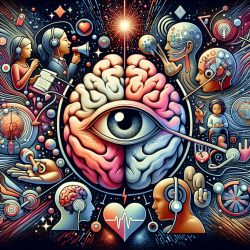The basal ganglia are traditionally known for their role in motor processing. However, recent research has highlighted their involvement in perceptual and cognitive functions as well. This expanded understanding is crucial for practitioners dealing with neuropsychiatric symptoms stemming from basal ganglia injuries.
Research Insights: Basal Ganglia and Neuropsychiatric Symptoms
A recent study titled "On Neuropsychiatric Manifestations of Basal Ganglia Injury: A Report of Three Cases and Literature Review" provides valuable insights into how basal ganglia pathologies can manifest as cognitive, perceptual, and affective disturbances. The study presents three cases with basal ganglia pathology demonstrating affective and psychotic symptoms.
- Case One: A 59-year-old male with schizoaffective disorder exhibited disorganized behavior and agitation. A CT scan revealed incidental bilateral basal ganglia calcifications.
- Case Two: A 71-year-old male diagnosed with schizophrenia showed symptoms like paranoid delusions and mood lability. Imaging confirmed small bilateral basal ganglia calcifications.
- Case Three: A 69-year-old female with schizoaffective disorder experienced visual hallucinations and cognitive dysfunction. CT scans indicated bilateral basal ganglia calcifications.
Implications for Practitioners
The findings from these cases emphasize the need for practitioners to consider neurological etiologies when encountering late-onset psychotic disturbances. Here are some ways practitioners can improve their skills:
- Advanced Imaging Techniques: Utilize MRI and CT scans to identify organic causes of new-onset psychoses.
- Comprehensive Assessment: Conduct thorough assessments that include cognitive evaluations to understand the full spectrum of symptoms.
- Treatment Strategies: Consider pharmacotherapy targeting neural networks involved in hallucinations and psychosis.
- Psychoeducation and Supportive Therapy: Augment medication with psychoeducation, supportive therapy, and cognitive-behavioral therapy to help patients cope with symptoms.
The Path Forward: Encouraging Further Research
The study highlights the importance of further research into the neuropsychiatric presentation of basal ganglia injuries. Understanding the correlation between subnuclei location within the basal ganglia and specific symptoms could lead to improved diagnosis and treatment strategies.
Practitioners are encouraged to delve deeper into this area by exploring existing literature and participating in research initiatives focused on basal ganglia pathologies. Such efforts could pave the way for innovative therapeutic approaches that address both motor and non-motor symptoms associated with these injuries.
To read the original research paper, please follow this link: On Neuropsychiatric Manifestations of Basal Ganglia Injury: A Report of Three Cases and Literature Review










